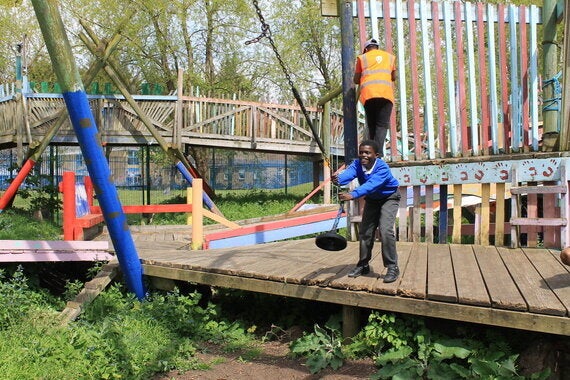
Government cuts. This phrase has dominated many a news story in the British media for the past six years. While we tend to associate the phrase with reduced spending on housing benefits or the National Health Service (NHS), there are some cuts which don't make the headlines. One example is local authority funding of adventure playgrounds.
Playgrounds are great, and growing up in the UK most of us will have benefitted from them at some point or another. So cuts to their funding are certainly sad, but not a matter of life and death as with the NHS - or are they? "Improving children's emotional and physical well-being is really important to help prevent other illnesses later in life. So in the long term if these sorts of services are cut, the NHS bill will get even higher", says creative community organiser Polly Robbins.
Even in the shorter term she may have a point - Robbins' current project is at Somerford Grove Adventure Playground in Tottenham, located in an area where 37.5% of children in Year 6 are obese (compared to 21.9% in London and 19.0% in England). Despite being the only playground of its kind in Haringey Borough, Somerford Grove has lost all local authority funding due to cuts. As a result, the playground is only open sporadically and at times staff work for free to make sure they open at least once a week.
Adventure playgrounds are particularly beneficial for childhood development because they encourage children to take risks, building their resilience and problem solving. This is why they need to be supervised by staff, who "usually go far beyond their remit as a play worker - they also signpost families to other local services and provide a support network for children and families, and can be independent confidants of children", adds Robbins.
Over the past 18 weeks, Robbins has been working as part of a small team of local artists and community organisers to run weekly art workshops based on Edward Lear's nonsense poem The Quangle Wangle's Hat. Children have been working with local artists to build huge sculptures of the heads of the fantastical characters from Lear's poem - an activity made all the more important by the fact that they will be doing less and less creative projects at school due to education reforms.
Being actively involved in building the structures with which they play is common in adventure playgrounds. "I've really enjoyed experiencing new things, and being able to be silly in front of people I don't know. And I like working with new stuff like wood - I wouldn't do that at home", said one child about the Quangle Wangle workshops.
Somerford Grove Adventure Playground is needed by the 13,000 5-15 year olds it serves perhaps more than others of its kind. It is located in Northumberland Park, the most deprived ward in Haringey, and among the most 2-3% most deprived nationally. According to Haringey council, life expectancy in the area is 7.7 years lower than that of Fortis Green and Highgate, Haringey's wealthiest wards.
It is easy to simplify the debate around the impact of some public spending cuts compared to others, and the benefits of adventure playgrounds are not immediately obvious. But these are community spaces which many of us will have used as children, parents or carers. And for me, the thought of a London without playgrounds is strange and almost frightening - but in the current political climate, could easily become a reality.
The sculptures made by the children and artists will be on show at The Quangle Wangle's Carnival, taking place at Northumberland Park on Saturday July 23rd. To find out more about Haringey Play Association, visit their website.